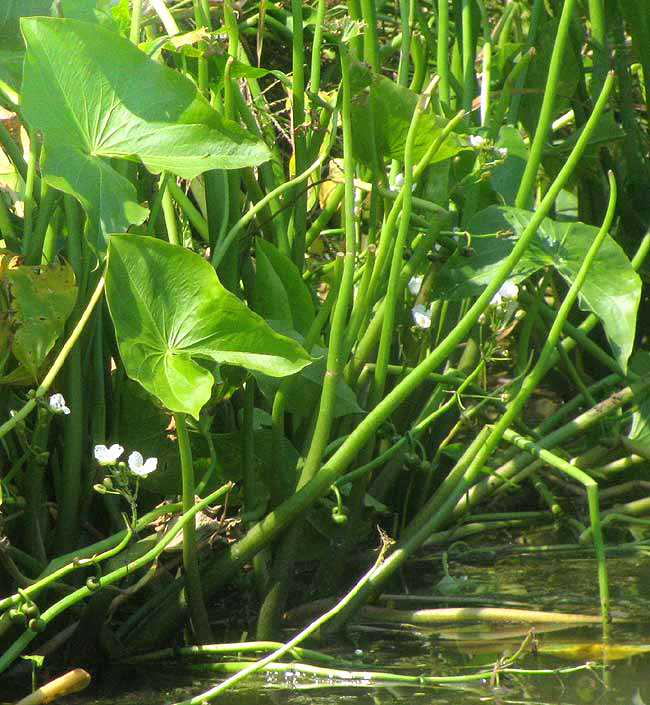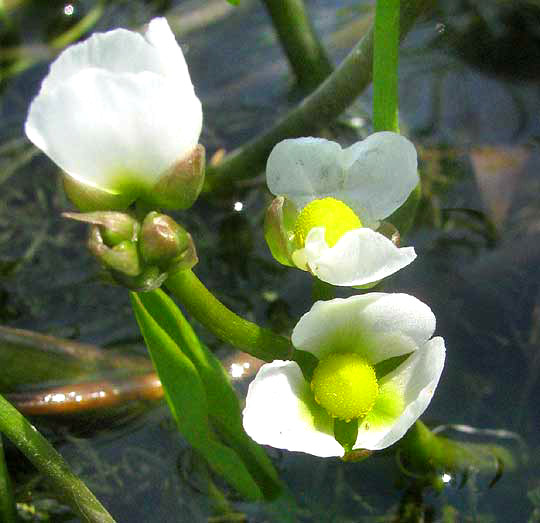Excerpts from Jim Conrad's
Naturalist Newsletter

from the the August 19, 2012 Newsletter issued from the woods of the Loess Hill Region a few miles east of Natchez, Mississippi, USA
HOODED ARROWHEADS
Along the muddy banks of Butler's Lake in St. Catherine Creek National Wildlife Refuge just south of Natchez a handsome aquatic plant with large, glossy, arrowhead-shaped leaves atop long, slender, succulent petioles form a pretty fringe, punctuated here and there with small clusters of inch-wide (2.5cm), white flowers hiding among shadows below the leaves, as shown above.
Anyone who hangs around wetlands soon learns that these water-loving plants can be called arrowheads. They're monocots, like lilies, orchids and grasses, and belong to the Water-plantain or Arrowhead Family, the Alismataceae, and the arrowhead genus, Sagittaria. I assumed that these plants were the Broadleaf Arrowhead, Sagittaria latifolia, commonly found throughout eastern North America south to northern South America. However, about 24 arrowhead species are treated in the online Flora of North America, so I figured I'd better confirm my assumption, and it's a good thing I did.
The above picture shows some important field marks I hadn't noticed while at Butler Lake. For example, in the photograph's lower, left corner, notice that on the thick flower-cluster stem, or peduncle, immature fruits are forming on similarly thick flower stems, or pedicles, and that the pedicels are shorter than the pedicles of the flowers above them, and strongly curved downward. Also, the green sepals below the developing fruiting heads wrap around the future fruits, instead of flaring outward or turning backwards. A close-up of some flowers shows another distinctive feature below:

Namely, the three petals, instead of being completely white as in most Arrowhead species, are conspicuously blotched below with yellow-green.
So, this isn't the Broadleaf Arrowhead, but rather one often called the Hooded Arrowhead. Experts are about evenly divided as to whether it's a variety of Sagittaria montevidensis, in which case its name is SAGITTARIA MONTEVIDENSIS var. CALYCINA, or whether it's a full species, Sagittaria calycina. The Flora of North America goes with the former, so that's how we'll list it here. The variety calycina is described as occupying mud flats of lakes and rivers in much of the central US, from West Virginia to Colorado, and southern Minnesota into Louisiana and eastern Texas, with outlying populations here and there, especially in California and Mexico. The broader species, montevidensis, differs in having dark purple spots at the petal bases, instead of yellow-green ones, and is a native of South America, but has been introduced in many places.
This and other arrowhead species produce peanut-sized, starchy tubers relished by ducks and other wildlife, as well as indigenous Americans in former times. Other names for arrowheads in general are Duck Potato and Indian Potato. In our first picture you may have noticed that many entire leaves had been stripped from their petioles. Beavers and muskrats are known to eat arrowhead leaves so probably that's what happened here. Leaf removal had been almost total over a large area. The leaves in our photograph appear to be smaller ones emerging after the removal of the first blades.
So, this is an important, worthy species and on that hot morning in the Refuge it was good seeing it thriving and contributing to the broader community so lustily there at the water's edge.
from the November 30, 2003 Newsletter issued from the woods of the Loess Hill Region a few miles east of Natchez, Mississippi, USA
DIGGING DUCK POTATOES
The other day neighbor Karen Wise dropped by and we went digging Duck Potatoes. Duck Potato is an aquatic plant about knee high, often growing in the bottom of drainage ditches and at the edge of ponds and lakes. Some grow in the ephemeral little sandy-bottom stream passing by the barn, and this is where we dug them.
The mature Duck Potato plant sends out underground runners at the end of which, maybe 15 inches (40 cm) from the plant's base, you find either a new plant sprouting, or a "duck potato." This tuber is white, somewhat egg-shaped, and about the size of a golf ball. Its flesh is harder than a regular potato's, but still it is succulent enough that if you have solid teeth you can bite into it. Its raw taste is bitter to a human but if it's boiled for about 30 minutes or roasted in campfire embers, its taste becomes similar to that of a white potato.
You can imagine that American Indians and early settlers ate duck potatoes with relish. Lewis and Clark developed a high regard for it. From what I can determine, ducks don't really eat a lot of this particular species because the tubers form too deep in the mud. It's a different matter with muskrats, however. In fact, I've read that the Indians often got most of their tubers from stores already assembled by muskrats.
Though the water was cold, Karen and I had fun digging our tubers. I think our hunter-gatherer instincts were aroused. With our fingers poked into the mud following underground runners, anticipation would build as we'd approach where we thought the tubers would be. Then when we found a large, well-formed one, it was a real treat. Seeing our collection of wholesome, nutritious tubers after a period of hard work was enormously gratifying.
We didn't eat our tubers, however. The next day I planted them all along our pond's banks in the hope that next year there'll be a nice population of them. Then maybe within a few years they'll be thick enough for us to dig tubers and eat them without feeling bad about depleting the population of this very pretty, important species.